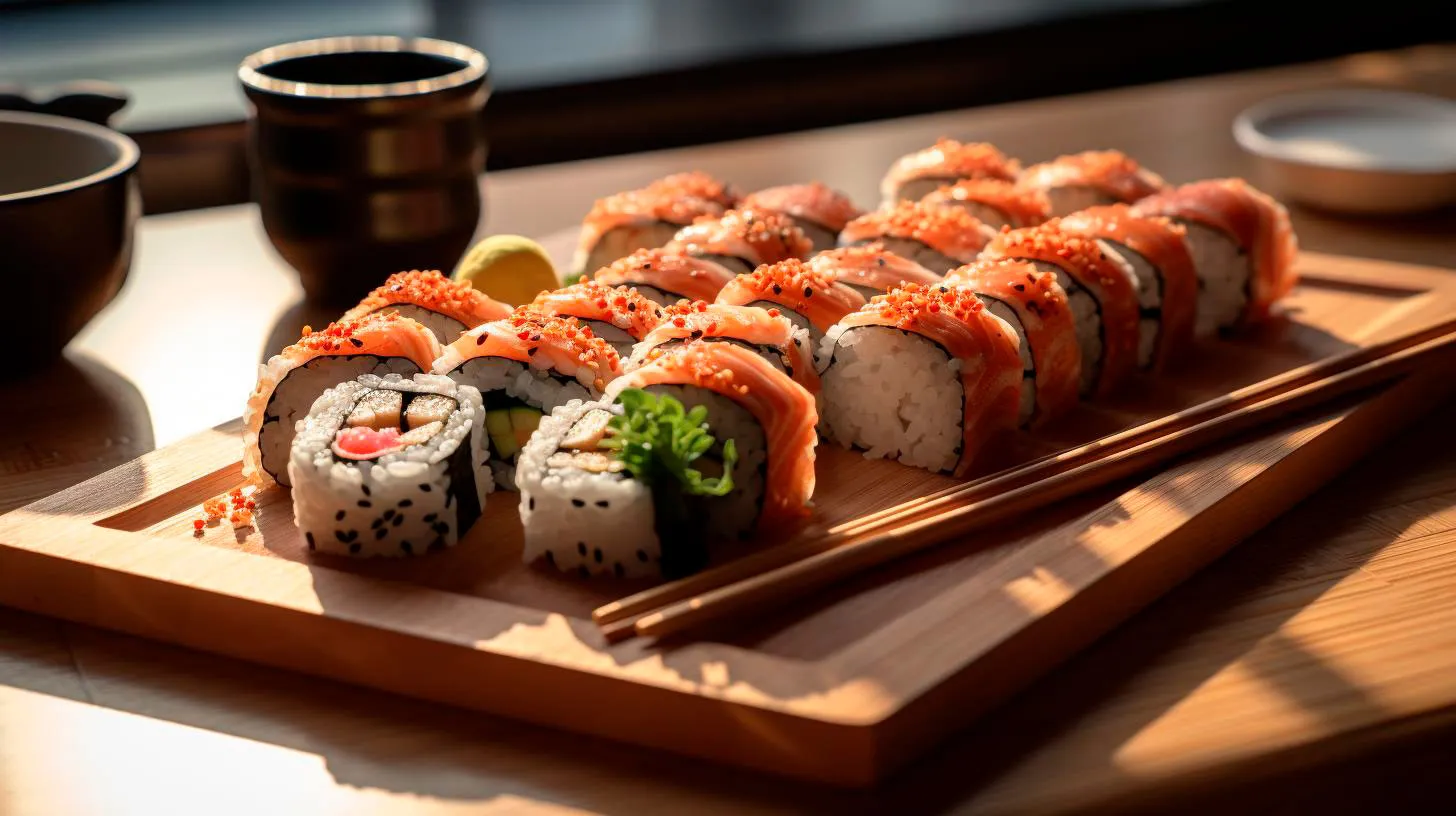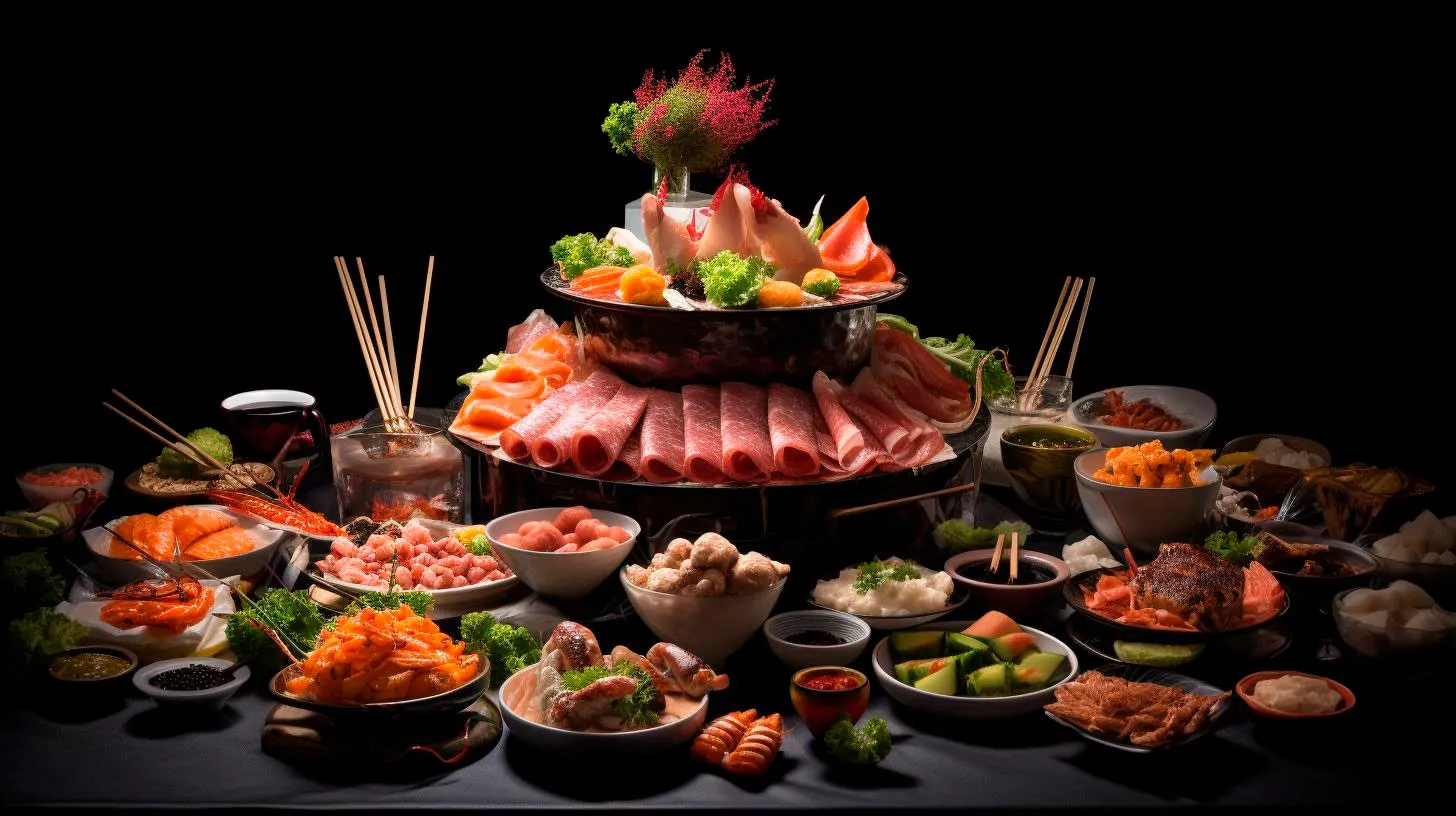The Key to Culinary Excellence: Sharpening Your Knife Skills in Nigiri Sushi
Behind the scenes, one crucial element separates the amateurs from the experts – knife skills. In this article, we will explore the art of sharpening your knife skills in Nigiri sushi, unlocking the secrets to culinary excellence.
The Importance of Knife Skills
Knife skills play a vital role in any culinary endeavor, and Nigiri sushi is no exception. A sushi chef’s ability to slice through the freshest ingredients with precision and finesse is what elevates their craft to the next level. Perfectly sliced fish and precisely shaped rice are the keys to creating beautiful and flavorful Nigiri sushi. However, achieving such precision requires not only talent but also a well-maintained and sharpened knife.
Benefits of Sharpening Your Knife
- Improved Precision: A sharp knife allows for clean and even cuts, ensuring that each piece of Nigiri sushi looks and tastes exceptional.
- Efficiency: Dull knives require more pressure and effort to cut through ingredients, leading to slower preparation times. Keeping your knife sharp helps you work more efficiently in the kitchen.
- Safety: A sharp knife is actually safer to use than a dull one. When using a dull knife, you are more likely to apply excessive force and lose control, increasing the risk of accidents.
Steps to Sharpen Your Knife
Now that we understand the importance of sharpening our knives for Nigiri sushi, let’s dive into the steps involved in achieving that razor-sharp edge.
1. Choose the Right Sharpening Tool
There are various tools available for sharpening knives, including sharpening stones, honing rods, and electric sharpeners. Select the method that best suits your needs and preferences. Sharpening stones, also known as whetstones, offer precision and control for those who are experienced. Honing rods are ideal for regular maintenance to keep the edge aligned. Electric sharpeners are convenient and quick, but they may remove more metal from the blade.
2. Prepare Your Knife
Before sharpening, clean your knife thoroughly to remove any dirt or residue. Dry it well to ensure a firm grip during the sharpening process.
3. Sharpening Technique
Hold the sharpening stone or honing rod firmly in place. If using a sharpening stone, angle the blade at approximately 20 degrees and glide it along the stone using consistent pressure. Repeat the process on both sides until a fine edge is achieved. If using a honing rod, hold it vertically and position the blade at a 15-degree angle. Slide the blade down the rod, starting from the base and ending at the tip, repeating the process on both sides.
4. Test Your Knife
To ensure your knife is sharpened to perfection, test it on a ripe tomato or a piece of paper. A sharp knife should effortlessly slice through without tearing or jagged edges.
Remember, sharpening your knife is an ongoing process. Regular maintenance and honing are necessary to keep your knife in top condition and guarantee excellent knife skills in Nigiri sushi preparation.
The Impact of Knife Skills on Nigiri Sushi
Now that we have sharpened our knives and honed our skills, let’s look at how this precision impacts our Nigiri sushi preparation.
1. Enhanced Flavor
When the knife slices through fish with precision, it minimizes tissue damage, preserving the delicate flavor and texture of the fish. Each bite of Nigiri sushi will be a burst of pure umami.
2. Aesthetically Pleasing Presentation
The precision cuts achieved through sharpened knives create uniform and visually appealing pieces of Nigiri sushi. The evenly shaped and well-proportioned sushi enhances the dining experience, both visually and texturally.
3. Consistency in Size and Shape
With sharp knives, you have greater control over shaping each piece of Nigiri sushi. Consistency in size and shape ensures both a pleasing aesthetic and equal distribution of toppings, guaranteeing a consistent flavor profile with every bite.
Celebrating Culinary Mastery
Mastering the art of sharpening your knife skills in Nigiri sushi brings you closer to culinary excellence. It unlocks a world of precision, flavor, and presentation that will impress your guests and elevate your culinary expertise.
So, grab your knives, sharpen them to perfection, and immerse yourself in the sensory delights of Nigiri sushi. With practice, patience, and razor-sharp precision, you can become a sushi chef extraordinaire.
A Cut Above the Rest: Mastering Knife Techniques for Nigiri Sushi
While nigiri sushi may appear deceptively simple, creating these bite-sized culinary delights requires years of training and meticulous attention to detail. In this article, we will explore the knife techniques that elevate nigiri to new heights, discuss the advantages of mastering these skills, and provide key takeaways for aspiring sushi chefs.
Mastering the Art of Knife Techniques
1. Precision Knife Cuts: Slicing fish for nigiri requires precise, controlled knife cuts. The chef must achieve uniform slices with consistent thickness to ensure optimal flavor and texture in each bite.
- Thin, delicate slices of fish enhance the taste and mouthfeel, allowing the flavors to meld harmoniously.
- The precision cuts in nigiri sushi showcase the freshness and quality of the ingredients.
2. Angle and Pressure: The angle and pressure applied by the sushi chef’s hand while cutting the fish play a vital role in shaping the perfect slice.
- A diagonal cut at a specific angle allows the fish to be draped over the rice beautifully, enhancing the overall presentation.
- The right amount of pressure ensures clean cuts and prevents the delicate fish from tearing or getting crushed.
3. Mastering Knife Skills: Sushi chefs spend years honing their knife skills, learning different cutting techniques to bring out the best in each type of fish.
- Each fish requires a specific cutting technique to highlight its unique flavor and texture.
- Developing knife skills also enables chefs to control thickness, resulting in a balance of flavors and a harmonious mouthfeel.
The Advantages of Mastering Knife Techniques
1. Enhanced Flavor: Mastering knife techniques allows sushi chefs to maximize the flavor of each ingredient, ensuring a perfect balance of taste in every bite.
- Uniform slices and precise cuts impact the release of flavors, resulting in a more enjoyable dining experience.
- The mastery of knife techniques enables chefs to bring out the natural essence of fish, enhancing its taste without overwhelming it.
2. Improved Texture: Proper knife skills contribute to the texture of nigiri sushi, highlighting its delicate and smooth mouthfeel.
- The thin slices obtained through precise knife cuts create a delicate texture that melts gently in the mouth.
- Mastery of knife techniques ensures that the sushi retains its form and texture, providing a delightful eating experience.
3. Artistry and Presentation: The art of nigiri sushi goes beyond taste and texture. The visual appeal is equally important, and knife techniques are fundamental to achieving a stunning presentation.
- The angle and precision cuts contribute to the aesthetic beauty of the dish, showcasing the craftsmanship of the chef.
- A visually captivating sushi presentation adds to the overall dining experience, creating a memorable moment for guests.
Key Takeaways for Aspiring Sushi Chefs
1. Practice, Practice, Practice: Mastery of knife techniques takes time and dedication. Practice regularly to improve your skills and develop the precision required for nigiri sushi.
2. Experiment with Different Fish: Each type of fish requires a different cutting technique. Explore a variety of fish to expand your knowledge and refine your knife skills.
3. Pay Attention to Ingredients: Quality ingredients are essential for nigiri sushi. Choose the freshest fish and the best rice to create a memorable culinary experience.
4. Continual Learning: Stay updated with the latest trends, techniques, and innovations in sushi making. Attend workshops, read books, and learn from experienced sushi chefs to continually improve your craft.
By mastering the intricate knife techniques that elevate nigiri sushi, sushi chefs can create a breathtaking experience for diners. The precision cuts, attention to detail, and artistry involved in the process make nigiri sushi a true art form. So, pick up your knife, sharpen your skills, and embark on a journey to become a true master of nigiri sushi.
The Art of Precision: Perfecting Knife Skills in Nigiri Sushi
The Importance of Knife Skills
Knife skills are the foundation of sushi making. The way a sushi chef handles their knife directly affects the taste, texture, and presentation of nigiri sushi. Each cut must be precise and consistent to ensure every piece of fish and rice is well-balanced and visually appealing. Here are some key reasons why knife skills are crucial:
- Enhances Flavor: Proper knife skills ensure that the flavors of fish and rice do not mix, allowing each ingredient to shine on its own.
- Texture and Mouthfeel: A skilled sushi chef can create different textures by cutting the fish in various ways, enhancing the overall dining experience.
- Visual Presentation: Nigiri sushi is not only about taste but also about aesthetics. Precise knife skills enable chefs to create beautiful and visually appealing sushi pieces.
- Efficiency: Well-honed knife skills allow sushi chefs to work efficiently, preparing sushi in a timely manner without sacrificing quality.
Mastering Knife Techniques
Now that we understand the importance of knife skills, let’s explore some essential techniques that sushi chefs use to create outstanding nigiri sushi:
1. Yanagiba (Sashimi Knife)
The yanagiba knife is the most commonly used knife for slicing fish in sushi preparation. Its long, slender blade allows for clean, single strokes, resulting in thin, even slices. The key here is to use a pulling motion rather than pushing the knife forward to maintain precision in every cut.
2. Deba (Fish Filleting Knife)
A deba knife is essential for breaking down and filleting whole fish. Sushi chefs use it to remove bones and skin, ensuring only the best cuts of fish are used for nigiri. It requires strength and precision to maneuver this heavy knife effectively.
3. Usuba (Vegetable Knife)
Although nigiri sushi mainly consists of fish and rice, the presentation often incorporates vegetables. An usuba knife is used to create intricate vegetable garnishes and precise cuts, bringing visual appeal to the plate.
Practicing Precision
Becoming a master of knife skills in nigiri sushi calls for countless hours of practice and proper technique. Here are some tips to help you on the way:
- Invest in Quality Knives: High-quality, sharp knives are a must for achieving precision. They will make your job easier and enhance the outcome.
- Maintain and Sharpen Your Knives: Regular maintenance and sharpening will keep your knives in top condition and ensure clean, effortless cuts.
- Focus on Hand-Eye Coordination: Your hand movements should be synchronized with your visual perception. Practice to develop your hand-eye coordination for precise cuts.
- Start with Basic Cuts: Begin by mastering basic knife cuts such as hikari (slices), katsura (thin strips), and oblique cuts. Gradually progress to more complex techniques.
- Seek Professional Guidance: Consider taking classes from experienced sushi chefs to refine your skills and learn professional techniques.
Remember, precision is the key to perfecting your knife skills in nigiri sushi. Every cut, slice, and chop contributes to the overall experience of this culinary art form.
Conclusion
The art of precision in sushi-making, particularly in nigiri sushi, demands exceptional knife skills. By mastering the techniques and practicing diligently, sushi chefs create visually stunning and delicious creations. The precise cuts made by skilled hands enhance the flavor, texture, and presentation of each nigiri sushi piece. Aspiring sushi chefs should focus on developing their knife skills to elevate their craft and truly appreciate the artistry behind this traditional Japanese delicacy.
So, pick up your knife and embark on the journey to become a master sushi chef, one precise cut at a time!
From Novice to Ninja: Mastering Knife Skills in Nigiri Sushi Preparation
One of the most essential skills that every sushi chef must master is the art of knife skills. In this article, we will take you on a journey from novice to ninja, guiding you through the steps to becoming a master in knife skills for nigiri sushi preparation.
The Importance of Knife Skills
Knife skills form the foundation of sushi preparation, and nigiri requires particular finesse. The ability to wield a sharp knife with precision is crucial for creating uniform and visually appealing slices of fish. Not only does it enhance the presentation of each piece of nigiri, but it also ensures the perfect texture and bite.
Mastering knife skills is a gradual process that requires practice, technique, and an understanding of different knife types. Whether you are a professional sushi chef or an enthusiastic home cook, improving your knife skills will greatly elevate your nigiri sushi game.
Key Knife Techniques for Nigiri Sushi
1. Knife Selection
- Invest in a high-quality, sharp knife specifically designed for sushi preparation.
- Choose a knife with a comfortable handle that fits your hand well to ensure precise control.
2. Knife Maintenance
- Regularly sharpen your knife to maintain its sharpness, as a dull knife can lead to uneven cuts and damage delicate fish.
- Properly clean and dry your knife after each use to prevent rusting.
3. Grip and Stance
- Hold the knife with a firm grip, but avoid gripping it too tightly as it may affect your control and precision.
- Adopt a stable stance, with your feet shoulder-width apart, to ensure balance and control during cutting.
4. Slicing Techniques
- Use a single swift motion to slice the fish, ensuring a clean and even cut.
- Practice your slicing technique to achieve consistent thickness and shape for each piece of nigiri.
Advantages of Mastering Knife Skills
Now that you understand the importance of knife skills in nigiri sushi preparation, let’s explore the benefits of mastering this essential culinary technique:
1. Enhanced Presentation:
Mastering knife skills allows you to create beautifully presented nigiri sushi, impressing guests and elevating their dining experience.
2. Perfect Texture:
Precise knife cuts ensure that each piece of nigiri has the ideal thickness and texture, enhancing the overall enjoyment of the dish.
3. Improved Efficiency:
Efficient knife skills enable you to prepare nigiri sushi more quickly and consistently, increasing your productivity in a professional setting.
4. Medium for Creativity:
Once you have mastered the basics of knife skills, you can unleash your creativity by experimenting with different shapes, colors, and ingredients to create unique and visually stunning nigiri creations.
Key Takeaways
Embarking on the journey to become a ninja master in knife skills for nigiri sushi preparation requires time, patience, and dedication. Here are the key takeaways you should remember:
- Knife skills are essential in creating visually appealing and perfectly textured nigiri sushi.
- Invest in a high-quality, sharp knife designed for sushi preparation and maintain it regularly.
- Practice your grip, stance, and slicing techniques to ensure precision and control.
- Mastering knife skills enhances presentation, texture, efficiency, and creativity in nigiri sushi preparation.
As you continue on your sushi-making journey, remember that mastering knife skills for nigiri sushi is not only about technique but also about the passion and love you bring to each slice. So, grab your knife, roll up your sleeves, and let your inner ninja chef shine!


